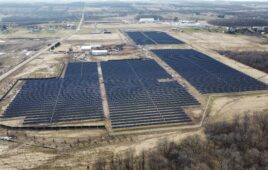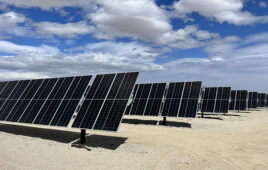Editor’s Note: This is the third article in a Robert Sternthal series on the state of the solar industry in Puerto Rico.
Robert Sternthal is president of Reznick Capital Markets Securities and has extensive experience in financing renewable energy transactions, whether they are in the wind, solar or biomass sectors. Working alongside CohnReznick LLP, Reznick Capital Markets Securities offers one of the most comprehensive financial advisory platforms in the industry
Will Puerto Rico’s Delays In Renewable Energy Rules Kill Solar There?
Confusion, naivete and clear lack of authority, by and among its government officials, may mean the answer is yes.
By Robert Sternthal, Solar Power World Contributor
Over the last several years, Puerto Rico has gone from being one of the most sought-after locations for projects to the least attractive. Many of the largest U.S. renewable energy developers, as well as those in Europe, have chased the dream that one day they would be able to build 20 to 100 MW of renewable energy projects in Puerto Rico, only to find that after several years and millions of dollars spent, they have nothing to show for their efforts.
For a renewable-energy developer, Puerto Rico had all the makings of a perfect storm for development — high cost of energy, U.S. jurisdiction that gave them access 1603 grants or the investment tax credit (ITC), and supposedly good contracts with an investment grade off-taker in the Puerto Rico Electric Power Authority (PREPA). In addition, there were viable investors for tax equity and long-term debt for the market.
So what happened?
In essence, the Puerto Rican government has allowed PREPA to continuously change the game, so one knows who is in charge. Is it the gGovernment or PREPA? To outside observers, it appears clear that PREPA is in charge. And despite whatever its leaders at any time tell the press, they do not want renewable energy. Why not? It’s cheaper. It’s cleaner. The people of Puerto Rico want it. But there’s another force at play here.
I believe that it has been well-documented that the local unions, who ultimately control the vote (and therefore PREPA), won’t allow it.
So, here’s how the game played out.
- PREPA gives out nearly 2,000 MW in power purchase contracts.
- PREPA changes leadership and goes after the former administration for irregularities or wrongdoing regarding some of the contracts that were executed.
- PREPA decides to enforce a new minimum technical requirement (MTRs) for the projects, claiming that they are necessary to protect the grid. Essentially, the MTRs require developers to put in a battery system that can cost as much as $10 million initially — and much more over time to maintain.
- PREPA repeatedly refuses to provide guidance on the MTRs or the operating procedures, such that no one will even consider financing the construction of a project in Puerto Rico.
- When PREPA is finally forced to provide such guidance, it is still unfinanceable because it includes provisions that would never be accepted by investors or lenders. This is not a bug. It’s a feature, and that’s obvious to anyone that has ever been in the energy business.
- Puerto Rico’s economy repeatedly worsens until there’s a downgrade in its credit and a resulting downgrade of PREPA.
- Nearly all of the major sponsors in the United States that have large balance sheets and the experience to build and maintain such projects abandon Puerto Rico, as their credit committees will no longer allow the investment.
- Nearly every single lender in the project financing world also abandons Puerto Rico and refuses to even consider financing projects in Puerto Rico. Why deal with a sub-investment grade credit in PREPA who continually stymies the process and is unwilling to establish a clear path to the construction and connection of renewable projects? Most lenders have enough to do in the burgeoning US market and new markets opening up such as Mexico.
- PREPA chooses its top 6, (then 10, then 20) projects where it forces developers to renegotiate their Power-Purchase and Operations Agreements (PPOAs). These PPOAs, mind you, are now barely financeable, worth less due to the MTR requirements, and still have no clear guidance on MTRs and operating procedures.
So will PREPA win? It certainly appears so. I have seen nearly every single project in Puerto Rico, and my personal belief is that only one or two can be built and completed in 2014. It is possible that another five to 10 will begin construction by year-end if you listen to the developers, but let’s examine some simple math.
- Puerto Rico wants 600 MW of renewable projects.
- Let’s just say they’re able to mobilize 500 MW and that each of the systems are built/valued at $3/Watt.
- That’s $1.5 billion in costs.
- That results in $500 million in ITCs (some have 1603 Grants, but these are subject to 7%+ sequestration).
- One to -two tax equity investors in the United States are willing to take $50 to$100 million in ITCs.
- One to two lenders are willing to lend up to $100 million in Puerto Rico, but possibly only with other requirements, such as guarantees, lock-up provisions, etc.
- Equity investors/sponsors willing to put up around $300 million (this is a guess, but based upon U.S. market, most developers are only willing to put up 20% of the total capital)
Can you do the math? Puerto Rico’s renewable sector is going to be short about $1 billion in financing.
I provided these numbers in a presentation at the Puerto Rican Renewable Energy Association’s (APER) seminar in the fall of 2013, but unfortunately, the people that really needed to hear it — the members of the government — had left by that time. I continue to wonder if they will ever hear or understand it, but even if and when they do, I wonder if they will wield the power to do anything about it.
I hope for the people of Puerto Rico that they do hear it and take constructive action, because if the ITC is not extended past 2016, they are running out of precious time.
Want more? Try these articles:
The State Of Solar Financing: Is Puerto Rico a Myth or the Next Big Solar Market?
Boy, Was I Mistaken — Solar In Puerto Rico? Definitely Maybe






Tell Us What You Think!